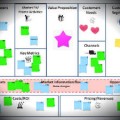In the previous post of this series on the MVP marketing plan we looked at the value proposition, customer needs, customer segments, market fit/promotional activities as well as the distribution channels on the MVP marketing plan.
We will now look at the rest of the elements that compose the MVP marketing plan.
 Key players
Key players
The key players are all the actors, internal and external that will need to be involved with the marketing activity you are using the MVP plan for. This box of the plan can be used to identify the resources you will need for your marketing activity. It can also be used to keep track of the order in which key players will be needed as well as their level of involvement. Any major issues with key players that may hinder their performance or capacity to deliver can also be noted in this box. If you are familiar with project management techniques you can use a RACI (responsible, accountable, contribute or inform) designation to instantly see the relative importance of the players at any given time during the activity.
A side benefit of this box is to easily see the load on your resources so you can prioritise or re-balance workloads in order to keep delivering on time.
![]() Key metrics
Key metrics
The key metrics are the data points you will be collecting and analysing to ensure that you are reaching the goals you have set for specific marketing activities. A key metric can be anything from analytics data to survey answers or observations you have noted. In the Lean Startup methodology key metrics are the heart of the measure part of the Build – Measure – Learn triad.
In traditional marketing, it’s the control part of marketing management. It is what tells you if you are going forward, backwards or sideways relative to your goals. Without it, you are blind to any progress or missteps. If a significant portion of your goals pertains to web activities, web analytics data will be the major (if not only) source of your key metrics. If this is your situation and you don’t have the internal expertise to gather and analyse web analytics data, I urge you to get external help while you crash learn about it.
 Pricing and Revenues
Pricing and Revenues
This is where you look at your pricing strategy for your marketing activity and the revenues you anticipate from it. Although the revenues from marketing activities are not always hard cash coming into the till, they should always be converted in $ (or whatever your local currency is). This, so you can figure out the return on your investments from the marketing activity you undertook. You will also need to compare your activities in term of ROI and see which types are the most valuable.
If your marketing activity impacts your pricing (discounts, promotional prices, new price category is created, etc.) this box will allow you to keep track of your pricing strategy and help you avoid, ‘’boxing yourself into a corner’’ price-wise, or other pricing issues that can creep up when your do multiple promotional activities that impact your pricing.
 Costs/ROI
Costs/ROI
This is the financial part of your marketing activity. You need to look at all the costs involved and compare them to the revenues expected to figure out your return on investment (ROI). The ROI is what will tell you whether or not you should go forward with your activity. Just like any other project, a marketing activity should never be undertaken if you don’t expect it to be profitable. It’s normal to not be good at forecasting your costs and revenues at first as you don’t have experience. It is essential that you keep at it and learn. Otherwise your marketing expenses can become a budgetary black hole that will engulf your entire business. On the flip side you can become so traumatised by allocating marketing budgets and never seeing returns that you will cease all marketing activities. In either case the end results will be deadly to your business.
Comparing the ROI from one activity to the next can also help you prioritise and spot the types of activities that are the most profitable for your business. In order to use this box in such a way, you will need to update your ROI information once your activity is completed as your real costs and revenues will differ from the projected ones you used to decide whether the activity was a go or no go.
Market Information Flow
This element is one of the more innovative aspects of the MVP marketing plan. Although every business knows market information is needed to operate, most of them do not realise the importance of allocating permanent resources to collect, analyse and diffuse information throughout the company. If you are going to operate in a fast moving market, (most markets that are not heavily regulated or deal with extremely high priced goods or services now fit this category) you will need to have your ear to the ground to hear threats, opportunities and changes in your customers’ need coming. A failure to see any of this can result in death or near death experiences for your business.
Businesses have always collected market information. It was usually the responsibility of the marketing team. The internet has since made the amount of available market information so huge that it is impossible for only a few people to gather, filter and use the pertinent information. This is why the market information conduit must go through every department in a company, ideally in real-time. Every single resource must be a gatherer and a user of market information as it pertains to their main task.
In the context of the MVP marketing plan, the market information flow element serves as a bulletin board where anyone who gets wind of information that could affect any aspect of the marketing activity itself can bring it forward so the adjustments can be made.
In the end, the market information flow box represents what being an entrepreneur is all about. You make a plan, shit happens and you have to deal with it quickly. In more elegant terms, being a successful entrepreneur is more about how fast you learn and react to those learnings than what you already know.
In our fourth and final post of this series we will take a look at ways to use the MVP marketing plan.
EDIT – Sept 2016 – Link fixes and pictures










